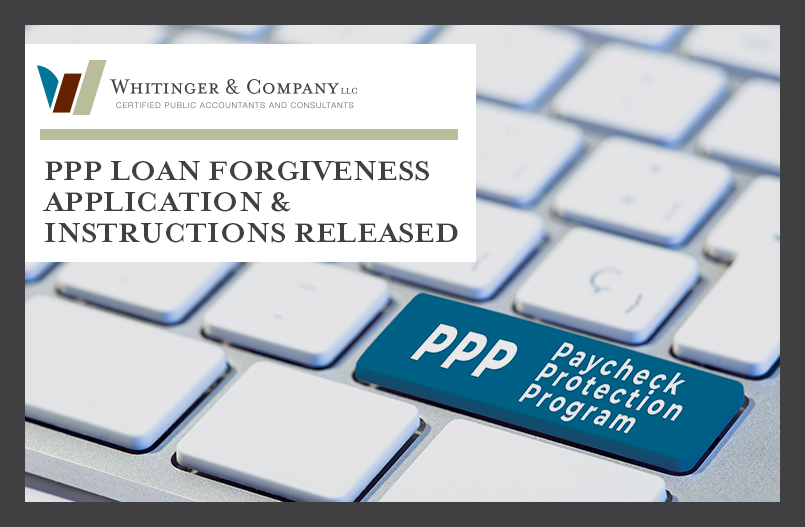The SBA and Treasury have released the PPP loan forgiveness application and instructions, as well as guidance allowing for loan amounts to be increased in limited situations. The complete loan forgiveness application, including instructions, and the loan increase guidance are attached. Based on recent history, we fully expect SBA and Treasury to continue to issue additional guidance regarding the forgiveness process and calculations.
Highlights from the PPP loan forgiveness application and instructions:
- Payroll costs:
- Borrowers with a biweekly (or more frequent) payroll schedule may elect to calculate eligible payroll costs using the eight-week period that begins on the first day of the first pay period following their PPP loan disbursement date. This alternative eight-week period, if elected, applies only to payroll costs.
- Eligible payroll costs are those costs incurred OR paid during the eight-week period. Payroll costs are considered paid on the day that paychecks are distributed or the borrower originates an ACH credit transaction. Payroll costs are considered incurred on the day that the employee’s pay is earned. Payroll costs incurred but not paid during the borrower’s last pay period of the eight-week period are eligible for forgiveness if paid on or before the next regular payroll date. Otherwise, payroll costs must be paid during the eight-week period. For each individual employee, the total amount of cash compensation eligible for forgiveness may not exceed an annual salary of $100,000 (prorated to $15,385 for the eight-week period). Payroll costs that were both incurred and paid during the eight-week period can only be counted once.
- For purposes of the forgiveness calculation, the definition of eligible payroll costs is the same as in prior guidance regarding calculation of the loan amount.
- Nonpayroll costs:
- For eligible nonpayroll costs (covered mortgage obligation interest, covered rent obligations, and covered utility payments), payment must be made during the eight-week period or incurred during the eight-week period and paid on or before the next regular billing date, even if the billing date is after the eight-week period. All eligible nonpayroll costs must be for loans/agreements/contracts originating before February 15, 2020. Nonpayroll costs that were both incurred and paid during the eight-week period can only be counted once.
- Covered utility payments are defined as business payments for a service for the distribution of electricity, gas, water, transportation, telephone, or internet access.
- Compensation to owners (owner-employee/self-employed individual/general partner):
- Eligible payroll for an owner is the amount paid to the owner. This amount is limited to $15,385 or the eight-week equivalent of their applicable compensation in 2019, whichever is lower.
- Salary/hourly wage reduction calculation:
- The loan forgiveness amount may be reduced if pay was reduced by more than 25% for any employee who did not receive compensation at an annualized rate of more than $100,000 for any pay period in 2019.
- To determine if a reduction has occurred, each employee’s average annual salary or hourly wage during the eight-week period is compared to the average annual salary or hourly wage between January 1, 2020 and March 31, 2020.
- The loan forgiveness amount will not be reduced for any employee whose average annual salary or hourly wage as of June 30, 2020, was equal to or greater than the employee’s annual salary or hourly wage as of February 15, 2020, and whose annual salary or hourly wage as of February 15, 2020, was greater than their average annual salary or hourly wage between February 15, 2020, and April 26, 2020.
- For an hourly worker, the amount of the reduction in hourly pay that exceeds 25% is multiplied by the average number of hours worked per week between January 1, 2020, and March 31, 2020, then multiplied by 8, to determine the total dollar amount of the reduction for that employee.
- For a salaried worker, the reduction in average annual salary that exceeds 25% is prorated (8 weeks / 52 weeks) to determine the total dollar amount of the reduction for that employee
- Salary/hourly wage reduction calculation:
- The loan forgiveness amount may also be reduced if the average weekly number of full-time equivalent employees during the eight-week period was less than during the borrower’s chosen reference period. The borrower may elect to use one of the following as the borrower’s reference period:
- February 15, 2019 – June 30, 2019; or
- January 1, 2020 – February 29, 2020; or
- For seasonal employers only, a consecutive twelve-week period between May 1, 2019, and September 15, 2019
- The loan forgiveness amount is not reduced due to a reduction in full-time equivalents if both the following conditions are met:
- The borrower reduced its full-time equivalent employee levels in the period beginning February 15, 2020, and ending April 26, 2020; and
- The borrower then restored its full-time equivalent employee levels by not later than June 30, 2020, to its full-time equivalent levels in the borrower’s pay period that included February 15, 2020.
- To determine the full-time equivalent for each employee, the borrower may elect to use either method below, but the same method must be used for all employees:
- The average number of hours worked per week, divided by 40, rounded to the nearest tenth, and capped at 1.0; or
- A simplified method that assigns 1.0 to all employees that worked 40 or more hours per week and 0.5 for employees who work fewer than 40 hours
- Borrowers do not include any reductions in full-time equivalents for:
- Any positions for which the borrower made a good-faith, written offer to rehire an employee during the eight-week period which was rejected by the employee; or
- Any employee who during the eight-week period
- Was fired for cause; or
- Voluntarily resigned; or
- Voluntarily requested and received a reduction of hours; and
- The position was not filled by a new employee
- The loan forgiveness amount may also be reduced if the average weekly number of full-time equivalent employees during the eight-week period was less than during the borrower’s chosen reference period. The borrower may elect to use one of the following as the borrower’s reference period:
- Payroll Cost 75% Requirement
- The maximum loan forgiveness amount cannot exceed payroll costs divided by 0.75.
- Documentation
- Page 10 of the instructions contains a list of the documentation that is required to be submitted to the lender with the loan forgiveness application. Page 10 also lists the documentation that each borrower must maintain in its records, but is not required to be submitted to the lender.
Highlights from the guidance for increasing loan amounts:
- For partnerships that did not include any amount for partner compensation in their original PPP loan application, the lender may submit a request through SBA’s E-Tran Servicing site to increase the PPP loan amount to include partner compensation, as long as the lender’s first SBA Form 1502 report to SBA on the PPP loan has not been submitted.
- For a seasonal employer that received a PPP loan before the alternative criterion for determining the maximum loan amount for seasonal employers became available (April 28, 2020), the lender may submit a request through SBA’s E-Tran Servicing site to increase the PPP loan amount, as long as the lender’s first SBA Form 1502 report to SBA on the PPP loan has not been submitted.
The Whitinger team remains available to advise you throughout this situation. Please do not hesitate to reach out if you have questions or would like to discuss this new guidance.
We are here and ready to help.



